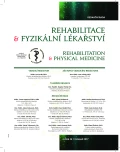Benefits and Drawbacks of Combined Therapy
Authors:
R. Poděbradská 1,2; J. Poděbradský 1,2; J. Urban 3,4
Authors‘ workplace:
Rehabilitace Lipová-lázně
1; Katedra podpory zdraví FSpS MU, Brno
2; Rehabilitace Fyziomed, s. r. o.
3; Katedara fyzioterapie FTK UP, Olomouc
4
Published in:
Rehabil. fyz. Lék., 24, 2017, No. 4, pp. 214-217.
Category:
Original Papers
Overview
The article summarizes current knowledge regarding the application of combination treatment (KT). It describes the neurophysiological aspects and application parameters of this method of physical therapy. To ensure efficiency and correct indication of KT, it is necessary to abide by the etiopathogenesis of reflex changes and the significance of their protective function. The authors state the most common types of reflex changes, their localisations suitable for KT treatment, and further on the benefits, as well as drawbacks, of this method, which must be taken into account while it is being indicated.
Keywords:
combination treatment, reflex changes, trigger point, ultrasonography
Sources
1. GERWIN, R. D., DOMMERHOLT, J., SHAH, J. P.: An expansion of Simons‘ integrated hypothesis of trigger point formation. Current Pain and Headache Reports 8, 2004, s. 468. ISSN 1531-3433.
2 HONOVÁ, K., STAŇA, J.: Piriformis syndrom – náhled komplexní léčby. Rehabilitácia, 53, 2016, 2. ISSN 0375-0922.
3. KIM, Y. et al.: Effects of the high-power pain threshold ultrasound technique in the elderly with latent myofascial trigger points: A double-blind randomized study. Journal of Back and Musculoskeletal Rehabilitation 27, 2014, s. 18. doi:10.3233/BMR-130414.
4. KOLÁŘ, P. et al.: Rehabilitace v klinické praxi. Praha, Galén, 2009, s. 58. ISBN 978-80-7262-657-1.
5. MACHÁČKOVÁ, K., VYSKOTOVÁ, J., JELÍNEK, O.: Porovnání účinku hloubkové oscilace a kombinované terapie na latentní spoušťový bod. Rehabil. fyz. Lék., 23, 2016, No. 1, s.16-23. ISSN 1805-4552.
6. PODĚBRADSKÝ, J., PODĚBRADSKÁ, R.: Fyzikální terapie – manuál a algoritmy. Praha, Grada Publishing, a.s., 2009, s. 184. ISBN 978-80-247-2899-5.
7. RICKARDS, L. D.: The effectiveness of non-invasive treatments for active myofascial trigger point pain: A systematic review of the literature. International Journal of Osteopathic Medicine, 9, 2006, 4, s. 121. doi:10.1016/j.ijosm.2006.07.007.
8 SIMONS, D. G.: Review of enigmatic MTrPs as a common cause of enigmatic musculoskeletal pain and dysfunction. J. Electromyogr. Kinesiol., 14, 2004, 1, s. 98. doi:10.1016/j.jelekin.2003.09.018.
7. TRAVELL, J. G., SIMONS, D. G.: Myofascial pain and dysfunction The trigger point manual, The upper extremities. Volume 1. Baltimore, Williams and Wilkins, 1982, s.26. ISBN 0-683-08366-X.
Labels
Physiotherapist, university degree Rehabilitation Sports medicineArticle was published in
Rehabilitation & Physical Medicine

2017 Issue 4
- Hope Awakens with Early Diagnosis of Parkinson's Disease Based on Skin Odor
- Deep stimulation of the globus pallidus improved clinical symptoms in a patient with refractory parkinsonism and genetic mutation
Most read in this issue
- Benefits and Drawbacks of Combined Therapy
- Assessment of Balance in Patients with Parkinson‘s Disease in Clinical Physiotherapeutic Practice
- Influence of Functional Electric Stimulation on the Hand Motoric after Cerebrovasvascular Event (stroke) a Preclinical Study
- The Use of Kinesio Taping in Overload of Physiotherapist’s Thumb
